#loxolophus
Explore tagged Tumblr posts
Text
It's been a while, but let's catch up with some more work I've done for PBS Eons:
• The enigmatic Paleodictyon, from "Something Has Been Making This Mark For 500 Million Years"

youtube
• The archaic ungulates Loxolophus, Arctocyon, and Eoconodon, from "How a Mass Extinction Changed Our Brains"



youtube
• And the nautilid Aturia, from "When Nautiloids Met Their Match"

youtube
———
NixIllustration.com | Tumblr | Patreon
#science illustration#paleontology#paleoart#palaeoblr#pbs eons#video#paleodictyon#loxolophus#arctocyon#arctocyonidae#eoconodon#mesonychia#ungulate#mammal#aturia#natuilida#nautiloid#cephalopod#mollusc#art#Youtube
431 notes
·
View notes
Link
Fossil hunters had not ignored the Corral Bluffs site. Indeed, they spent the last century scrounging for fossils there. Yet few fossils turned up — until paleontologist Tyler Lyson realized he had been looking in the wrong place. In 2016, he began focusing on nodules of rock, called concretions (Kon-KREE-shuns). He found lots of fossils inside them, not scattered among surface rocks.
Says Lyson, “That was the real game-changing moment when I broke open the first concretion and saw a mammal skull staring back at me.”
By comparing plant and animal fossils with data on precise dates for the rocks, the researchers puzzled together what happened at Corral Bluffs 65 million to 66 million years ago. Following global devastation caused by the asteroid impact, ferns and palms dominated quickly came to dominate. Slowly, forests with a much greater diversity of trees replaced them.
Mammals took a little while to recover. But in time they swiftly diversified into a variety of forms and sizes. About the size of a rat, the biggest initial survivors of the impact weighed just 500 grams (1.1 pounds). But rock from 100,000 years later hosts fossils of raccoon-sized mammals that would have weighed up to 6 kilograms (13.2 pounds), Lyson says. That’s not far from biggest mammals that existed before the mass extinction.
By 300,000 years after the impact, some mammals were now 25 to 30 kilograms (55 to 66 pounds). This included the beaver-sized Carsioptychus. What led to that growth in their size? A lack of large predators in the post-impact world have helped. So would an explosion in plant diversity, which would have given them a wider array of dining choices.

By 300,000 years after the asteroid impact, mammals such as the raccoon-sized Loxolophus (illustrated), foraged for food in forests dominated by palm trees.
CREDIT: HHMI TANGLED BANK STUDIOS
By 700,000 years after the mass extinction, these rock deposits held fossils of the earliest known members of the legume, or bean, family. Mammals also appeared weighing nearly 50 kilograms (110 pounds), such as the wolf-size Eoconodon.
The sheer number of fossils and different time slices revealed at Corral Bluffs, astound Brusatte, in Edinburgh. So did the number of mammal skulls — at least 40 so far. Skulls are usually very rare. In fact, mammals from around this time are typically “known just from teeth, and maybe a few bones here and there,” he says.
Brusatte is working on a related site in New Mexico. It is among the very few others with similarly aged vertebrate fossils. Though those fossils are less complete, they too point to a rapid recovery and diversification of mammals after the impact. “Different areas are giving the same signal,” he says. “That tells us that it’s probably true.”
Many mammals before the impact were very different from those today. For instance, so-called “placental” mammals came to dominate. These are animals whose young develops in a womb. Today, they account for some 95 percent of the roughly 6,500 mammal species alive.
Corral Bluffs “is the best record” showing how land-based ecosystems recovered from the K–Pg extinction, says Jin Meng. He’s a paleontologist and expert on dinosaur-era mammals at the American Museum of Natural History in New York City. The newfound fossils show “at least part of the earliest record — part of the trunk — of the placental mammal tree of life.”
23 notes
·
View notes
Text
科學家首次描述6600萬年前生態系統
近日,在《科學》發表的一篇論文中,科學家描述了在科羅拉多州中部康瑟爾布拉夫斯發掘的一批化石。
他們提到在小行星撞擊地球後關鍵的100萬年中,保存完好的動植物化石揭示了地球上最黑暗的日子之後,生命復甦的景象。
“6600萬年前,地球上的生命軌跡發生了根本性的變化。一顆巨大的小行星摧毀了整個地球的生態系統。此後的地球一直籠罩在神秘中,我們沒有很好的化石幫助了解生命之樹的演化。”該研究通訊作者之一、丹佛自然與科學博物館古植物學家Ian Miller說。
“這些化石告訴我們,人類作為一個物種的旅程——我們是如何來到這裡的。”未參與該研究的芝加哥大學的古生物學家Neil Shubin說。

浣熊大小的Loxolophus和其他哺乳動物在白堊紀末期大滅絕後的進化快得出奇。圖片來源:HHMI TANGLED BANK STUDIOS
最早倖存者
所有現代哺乳動物,包括人類,都可以被認為是那次撞擊的最早倖存者。
“6600萬年前的某一天,地球上的生命軌跡發生了巨大的變化。”通訊作者之一、丹佛自然與科學博物館古脊椎動物學家Tyler Lyson告訴《中國科學報》,“一顆小行星轟炸了我們的星球,導致3/4的生物滅絕。雖然那是地球上生命最糟糕的時期,但有些東西倖存了下來,包括人類最早的祖先。”
而新發現的動物和植物化石,讓研究人員能了解恐龍滅絕後100萬年間的生命演變,這恰好是現代世界的起源。
Lyson說:“我們對小行星撞擊地球的後果的了解一直是碎片化的。這些化石第一次告訴我們,我們的星球究竟是如何從這場全球性災難中恢復過來的。”
Lyson在富含化石的北達科他州長大,當他還是個孩子的時候,就對恐龍的命運之謎很感興趣。十幾歲時,他就成為了一個老練的“恐龍獵手”。
在恐龍存在和不存在的地方有一個眾所周知的模式:在某個界限之上,似乎不再有恐龍。
後來,Lyson知道了,這個邊界層也是世界改變的標誌事件:一顆小行星撞擊地球。天外來客在墨西哥尤卡坦半島砸出來一個20英里深、100多英里寬的大坑,大量熔岩和白熱化的玻璃珠子從天而降。
地面上的生物被烤焦了,天空變暗了。之後,植物枯萎、森��崩潰,所有的恐龍——除了鳥類——都滅絕了。
遊戲規則改變者
多年來,Lyson等人一直在靠近小行星撞擊層的區域尋找脊椎動物化石。直到2016年,他們才發現了邊界上方的那塊岩石。
“那年夏天,一個偶然的機會指引我們找到了那些化石,實際上它們就躺在我們眼前。”Lyson說。
Lyson的靈感來自於博物館收藏抽屜裡的一塊化石,以及南非同事使用的化石搜尋技術。他不再在丹佛盆地尋找閃爍的骨頭碎片,而是把注意力集中在被稱為“混凝土”的蛋形岩石上。
“這絕對是一個靈光一現的時刻,是遊戲規則的改變者。”Lyson說。
打開混凝土,Lyson和Miller發現了奇蹟:裡面是大滅絕早期哺乳動物倖存者的頭骨。
“找到這個時代的哪怕一個頭骨都是一件了不起的事。事實上,對這個時代的大部分認識都是基於化石的微小碎片,比如哺乳動物的牙齒碎片。你可能一輩子都找不到這個時期動物的頭骨,這就是它們的稀有之處。”Miller告訴《中國科學報》。
在接下來的幾個月裡,研究人員挖出了數千塊化石,包括植物、爬行動物和16種不同的哺乳動物化石。借助這些化石,研究人員拼湊出“至暗時刻”之後生態系統,以及這些動物有生命的、會呼吸的真實樣子。
那時的生命
該博物館首席執行官George Sparks說:“多虧了科學團隊的專業技能、遠見和勇氣,我們對現代哺乳動物世界如何從恐龍的灰燼中崛起有了更清晰的認識。”
展現在人們眼前的是一幅錯綜複雜的畫面:在小行星撞擊地球之後,植物和動物生命的複活是交織在一起的。
結合一項引人注目的植物化石記錄和哺乳動物化石的發現,研究小組得以將數千年的變暖現象與全球事件聯繫起來,其中包括印度次大陸上的大量火山活動。這些事件可能塑造了遠在半個地球之外、如今已不復存在的北美生態系統。
“我們記錄了撞擊後景觀的變化,從一個以棕櫚樹為主的世界到一個以更多樣化的樹木為主的世界。我們還看到了動物物種的同步變化。
然後我們把它和環境溫度的變化聯繫起來,把所有的碎片放在一起,描繪出了一幅現代世界出現的畫面。 ”Miller說。
英國倫敦自然歷史博物館古生物學家Anjali Goswami說:“直到小行星撞擊徹底毀滅了恐龍��哺乳動物才爆發出我們今天看到的驚人的多樣性。”
“我們在康瑟爾布拉夫斯看到的這種恢復模式是一個地區的黃金標準,現在我們希望弄清它是正常的還是不正常的。令人興奮的是,這並不是故事的結局,而是一件大事的開始。”Lyson說。
.
from 科學家首次描述6600萬年前生態系統 via KKNEWS
0 notes
Text
Fossil trove shows life's fast recovery after big extinction
https://sciencespies.com/biology/fossil-trove-shows-lifes-fast-recovery-after-big-extinction/
Fossil trove shows life's fast recovery after big extinction
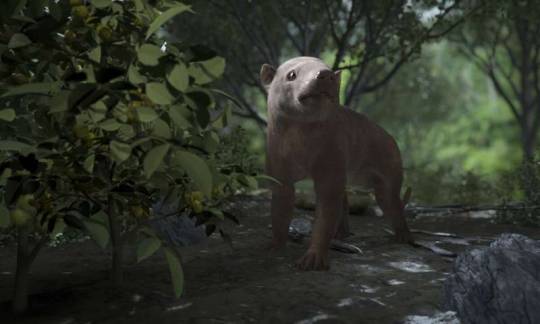

This image provided by HHMI Tangled Bank Studios in October 2019 shows a rendering of the ancient Carsioptychus mammal taken from the PBS NOVA special, Rise of the Mammals. In this recreation, Carsioptychus coarctatus eats plants in a newly diversified forest, 300,000 years after the mass extinction that wiped out the dinosaurs. (Jellyfish Pictures/HHMI Tangled Bank Studios via AP)
A remarkable trove of fossils from Colorado has revealed details of how mammals grew larger and plants evolved after the cataclysm that killed the dinosaurs.
The thousands of specimens let scientists trace that history over a span of 1 million years, a mere eyeblink in Earth’s lifespan.
Sixty-six million years ago, a large meteorite smashed into what is now the Yucatan Peninsula of southeastern Mexico. It unleashed broiling waves of heat and filled the sky with aerosols that blotted out the sun for months, killing off plants and the animals that depended on them.
More than three-quarters of species on Earth died out.
But life came back, and land mammals began to expand from being small creatures into the wide array of forms we see today—including us.
So the new find taps into “the origin of the modern world,” said Tyler Lyson, an author of a paper reporting the fossil finds Thursday in the journal Science.
The fossils were recovered from an area of steep bluffs covering about 10 square miles (17 square kilometers) near Colorado Springs, starting three years ago.
Lyson, of the Denver Museum of Nature and Science, found little in that area when he followed the standard practice of scanning for bits of bone. But that changed when he began looking instead for rocks that can form around bone. When the rocks were broken open, skulls and other fossils within were revealed.
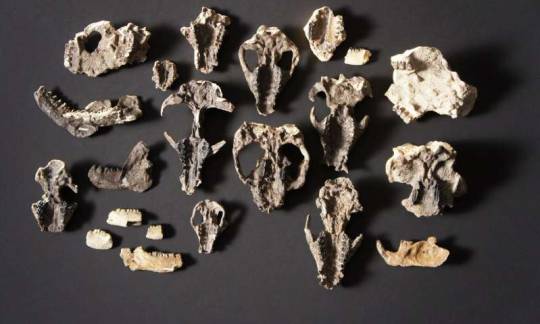
This photo provided by HHMI Tangled Bank Studios in October 2019 shows some of the mammal skull fossils retrieved from Corral Bluffs, Colo. A trove of fossils has revealed details of how life rebounded after the cataclysm that killed off the dinosaurs. (Frank Verock/HHMI Tangled Bank Studios via AP)
Lyson said it’s not clear how wide a geographic region the fossils’ story of recovery applies to, but that he thinks they show what happened over North America.
“We just know so little about this everywhere on the globe,” he said. “At least now we have at one spot a fantastic record.”
Experts not connected to the study were enthusiastic.
It’s “an unparalleled documentary of how life on land recovered” after the asteroid impact, said P. David Polly of Indiana University in Bloomington. “The sheer number of fossil specimens and the quality of their preservation are exceptional” for this time period, he said.
The fossils’ story certainly represents what happened in central North America and perhaps more broadly, he wrote in an email.
Stephanie Smith of the Field Museum in Chicago said the study’s detailed focus on a single area can help scientists understand the complexity of recovery when combined with results from elsewhere.
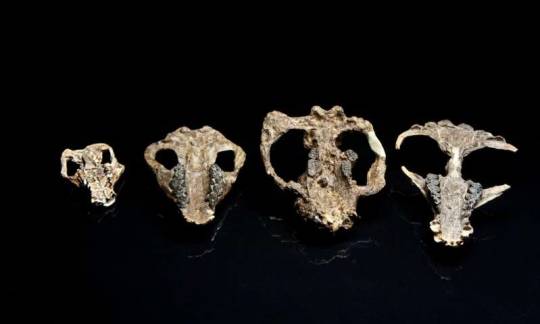
This photo provided by HHMI Tangled Bank Studios in October 2019 shows a collection of four mammal skulls collected from Corral Bluffs, Colo. From left are Loxolophus, Carsioptychus, Taeniolabis, Eoconodon. A trove of fossils has revealed details of how life rebounded after the cataclysm that killed off the dinosaurs. (HHMI Tangled Bank Studios via AP)
Scientists have previously found little evidence about what happened in the aftermath of the meteorite crash, especially on land, said Jin Meng of the American Museum of Natural History in New York. The new work, he said in an email, appears to provide “the best record on Earth to date.”
The study reports on hundreds of mammal fossils representing 16 species and more than 6,000 plant fossils. Researchers also analyzed thousands of pollen grains to see what plants were alive at various times. Analysis of leaves indicated several warming periods during the period.
Here’s the recovery story the fossils tell:
The area had been a forest before the meteorite hit, home to dinosaurs like T. rex and mammals no bigger than about 17 pounds (8 kilograms).
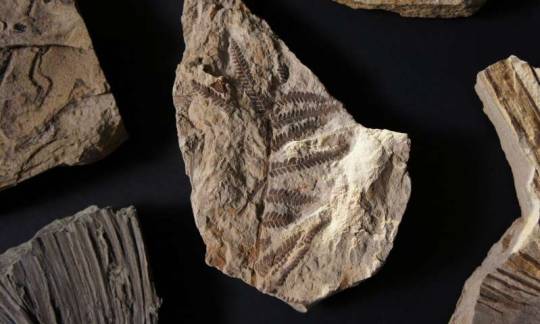
This photo provided by HHMI Tangled Bank Studios in October 2019 shows a fern fossil collected from Corral Bluffs, Colo. A trove of fossils has revealed details of how life rebounded after the cataclysm that killed off the dinosaurs. (Frank Verock/HHMI Tangled Bank Studios via AP)
Soon after the disaster, the environment was blanketed with ferns and the biggest mammal around was about as heavy as a rat. The world was in a warming period, as documented in previous studies.
By about 100,000 years after the meteorite impact, the forest was dominated by palm trees and mammals had grown to the weight of raccoons, almost as big as before the meteorite crash. “That’s a pretty rapid recovery, or at least one aspect of recovery,” Lyson said.
By 300,000 years, the walnut tree family had diversified, and the biggest mammals were plant eaters about as heavy as a large beaver. Based on other studies of their diet, they may have evolved along with those trees, Lyson said.
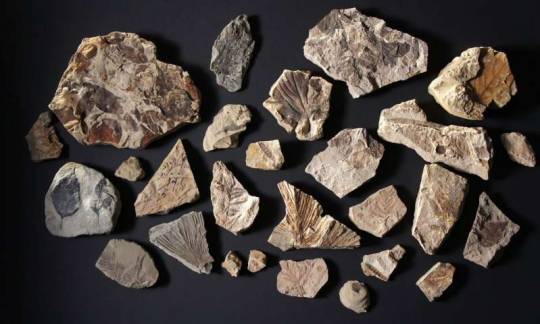
This photo provided by HHMI Tangled Bank Studios in October 2019 shows some of the plant fossils retrieved from Corral Bluffs, Colo. More than 6,000 leaves were collected as part of the study to help determine how and when Earth’s forest rebounded after the mass extinction event. (Frank Verock/HHMI Tangled Bank Studios via AP)
By 700,000 years, the fossil record shows the first known appearance of legume plants, the family that includes peas and beans. And it reveals the two largest mammals found in the study, with the larger one weighing about 100 pounds (50 kilograms), roughly like a wolf. That is about 100 times heavier than the mammals that survived the extinction, “which I think is pretty fast” for growth, Lyson said.
What drove mammals to get bigger? The main factor was the disappearance of the dinosaurs, leaving an ecological niche to be filled, he said. But the quality and types of food on the landscape probably also played a role, he said. The simultaneous appearance of legume plants and bigger mammals suggests the plants may have provided a “protein bar moment,” Lyson said.
He said the mammals were creatures that evolved from animals that had survived extinction or those that immigrated from elsewhere.
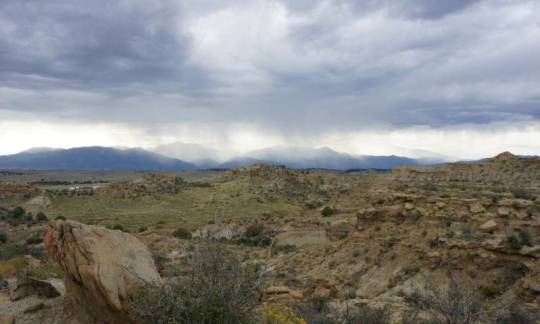
In this photo provided by HHMI Tangled Bank Studios in October 2019, a storm rolls in towards Corral Bluffs, Colo, outside of Denver. The area represents about 300 vertical feet of rock and preserves the extinction of the dinosaurs through the first million years of the Age of the Mammals. The exposure is composed of hard yellow sandstone and mudstones, which represent ancient rivers and floodplains, respectively. (Frank Verock/HHMI Tangled Bank Studios via AP)
Zhe-Xi Luo of the University of Chicago, who did not participate in the work, said the report is remarkable for tying together records for plants, mammals and temperature, giving a “holistic picture.”
Scientists expected mammals to recover after the dinosaur extinctions, he said, and the new work “is a huge step forward in getting a firm understanding about just how it happened.”
Explore further
Researchers discover first winged mammals from the Jurassic period
More information: T.R. Lyson el al., “Exceptional continental record of biotic recovery after the Cretaceous-Paleogene mass extinction,” Science (2019). science.sciencemag.org/lookup/ … 1126/science.aay2268
“Stepping out of the dinosaurian shadow,” Science (2019). science.sciencemag.org/lookup/ … 1126/science.aaz6313
© 2019 The Associated Press. All rights reserved.
Citation: Fossil trove shows life’s fast recovery after big extinction (2019, October 24) retrieved 24 October 2019 from https://phys.org/news/2019-10-fossil-trove-life-fast-recovery.html
This document is subject to copyright. Apart from any fair dealing for the purpose of private study or research, no part may be reproduced without the written permission. The content is provided for information purposes only.
#Biology
0 notes
Text
Colorado Fossils Show How Mammals Raced to Fill Dinosaurs’ Void
Some 66 million years ago, mammals caught their lucky break. An asteroid crashed into what is now Chicxulub, Mexico, and set off a catastrophic chain of events that led to the annihilation of the non-avian dinosaurs. That day began their furry ascension to the top of a brave new world, the one from which our species would one day emerge. But little is known about the time period directly after the Cretaceous-Paleogene extinction, or K-Pg event, because the fossil record is lacking.
Now, a team of paleontologists has uncovered a trove of thousands of fossils in Colorado that provides an in-depth look at the first million years following the K-Pg mass extinction event. The finding provides insight into the interactions between animals, plants and climate that occurred in the earliest days of the age of mammals, and that allowed them to grow from the size of large rodents into diverse wildlife we might begin to recognize today.
“We provide the most vivid picture of recovery of an ecosystem on land after any mass extinction,” said Tyler Lyson, a vertebrate paleontologist at the Denver Museum of Nature and Science. His team’s paper was published on Thursday in Science.
Dr. Lyson has hunted fossils since he was 10. Although he has found many dinosaurs, uncovering fossils of species that emerged in the immediate aftermath of the dinosaur extinction had proven rather elusive in his field of study.
“You can only find so many triceratops skeletons and partial T. rex skeletons and things like that until you want a larger challenge,” said Dr. Lyson. “Finding fossils just after the K-Pg extinction is a huge, huge challenge.”
In spring 2016 he and some colleagues explored a fossil site near Colorado Springs called Corral Bluffs. He knew that years earlier, Sharon Milito, an amateur fossil hunter, had found a mammal skull that was confirmed to be from the K-Pg boundary there. He set out looking for mammal bones sticking out of the ground. But his search proved fruitless.
As he wandered around the bluff, he thought back to his time as a graduate student working in South Africa. There, he had learned to spot certain rocks called concretions that held fossils captive, like pearls in oysters. He shifted his focus from bones to rocks.
“I found this ugly white-looking rock that looked like it had a little mammal jaw coming out of it,” Dr. Lyson said. He cracked it open and found inside part of a fossilized crocodile. “That was the moment when the light bulb went off. If there’s one concretion with fossils inside, there’s got to be more.”
He and his colleagues returned to Corral Bluffs that September and searched for more of the ugly rocks.
“When I cracked open the very first concretion I found a mammal skull,” Dr. Lyson said.
It was the most complete mammal from the K-Pg interval that he had ever seen. Within an hour they found four or five more. So far, they have uncovered more than 1,000 vertebrate fossils and 16 different mammal species.
“With this discovery, we’re starting to see the entire skull of many of these mammals that we previously only knew from teeth,” said Stephen Chester, a mammalian paleontologist at Brooklyn College and an author on the paper.
The skulls tell a story of mammalian resilience. Whereas rat-size mammals survived the extinction event, raccoon-size ones perished. About 100,000 years after the K-Pg event, mammals bounced back, with raccoon-size mammals reappearing.
Some 300,000 years after the asteroid struck, more mammals appeared, such as Loxolophus and the small pig-size Carsioptychus appeared. Within 700,000 years, the capybara-size Taeniolabis and the wolf-size Eoconodons began to thrive.
“You’re going from a very small dog that you’d see on the streets on New York City to a very large wolf within those hundreds of thousands of years,” Dr. Chester said.
The team also collected more than 6,000 fossilized leaves and analyzed more than 37,000 pollen grains. Together the items describe the re-emergence of plant life, which may have been a crucial factor in the evolution of mammals.
First came the ferns. With their feather-like leaves, they proliferated across the wasteland for many hundreds of years to a couple thousand years, paving the way for forests to rebound.
Next, the palms paraded in, dominating the green scene for hundreds of thousands of years.
Then around 300,000 years after the catastrophe, a diverse array of walnuts appeared. That coincided with the jump in diversity and body size of herbivorous mammals, which suggests they were an important food source.
“We call that world the ‘Pecan Pie World,’” said Ian Miller a paleobotanist at the Denver Museum of Nature and Science. He added that this epoch also coincided with a warming period in the fossil record, which could indicate that a shifting climate played a role in the development of plants and animals following the extinction event.
One of their most important botanical finds — a fossil bean pod — was made one summer by a high school student while the team was working with NOVA for a documentary that will be broadcast Wed., Oct. 30 on PBS.
“There she is holding the world’s earliest fossil legume,” Dr. Miller said. “She just had this ear-to-ear smile, totally beaming.”
They dated the legume to around 700,000 years after the mass extinction event. That period was tied to another short warming pulse, as well as to the appearance of the wolf-size mammals. Perhaps the legumes were fueling furry animals, the team suggested.
“We liken them to the protein bars of the ancient world,” Dr. Miller said. One remaining question, he added, is whether climate drove the changes in the plants and mammals.
Courtney Sprain, a geoscientist at the University of Florida, said she was impressed by their animal, plant and climate records. “That’s one of the really spectacular things about this paper, just how amazing the preservation is and how good the record is for a variety of different changes following a mass extinction.”
Other paleontologists agreed.
“I looked at this and went ‘Wow, that’s a lot of skulls!’” said Jaelyn Eberle, a vertebrate paleontologist at the University of Colorado at Boulder, who was not involved in the paper. She said a next step should be to perform micro CT scans on the skulls, to determine the brain sizes and compartments, which would provide insight into the animals’ sensory abilities.
The find also helps elucidate how species are able to respond to catastrophic events in a relatively rapid time frame.
“It has obvious ramifications for the current biodiversity and climate crisis, as we start to approach similar levels of devastation,” said Anjali Goswami, a vertebrate paleontologist at the Natural History Museum in London. The current crisis, she added, is “ unfortunately caused by our own shortsighted avarice, rather than a chance encounter with an extraterrestrial body.”
Sahred From Source link Science
from WordPress http://bit.ly/2WaZgLb via IFTTT
0 notes